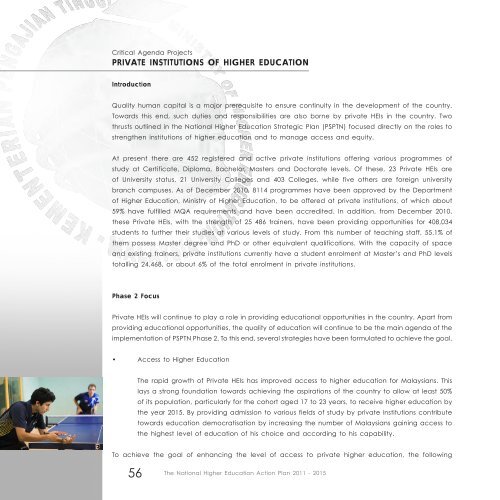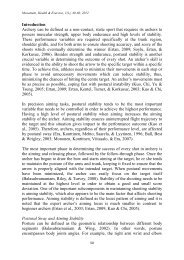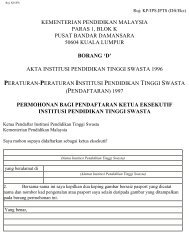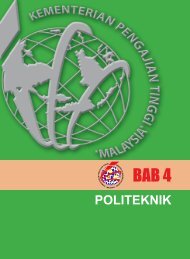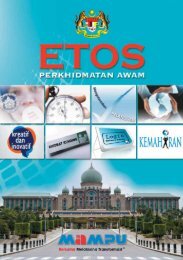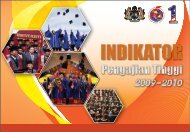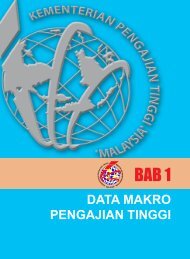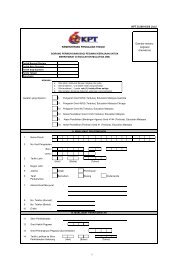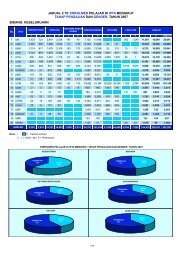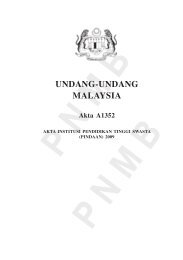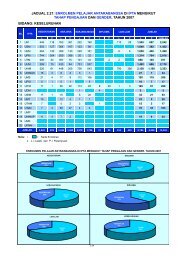Jika Specifically, dilihat dari PSPTN segi pencapaian acknowledges kebolehpasaran the need for siswazah the curriculum bagi setiap provided IPTA pula, by peratus HEIs to pencapaian be consistent adalah andberbeza in line with di antara global satu market sama needs lain. Pada in order akhir to tahun produce 2010, high sejumlah quality 19 graduates IPTA terlibat who dalam are statistik employable. pengiraan TheCAP critical Kebolehpasaran success factors Siswazah are based dan hanya on: satu IPTA iaitu Universiti Malaysia Kelantan (UMK) masih belummenghasilkan siswazah pada tahun 2010. Secara umumnya, universiti yang berstatus universiti penyelidikan,mempunyai • tahap the involvement peratusan kebolehpasaran of the industry in siswazah shaping the yang curriculum melebihi to 75%. improve Pencapaian graduate bagi employability Universitiin terms of skills and job fit.Pendidikan Sultan Idris (UPSI) adalah 96.5% kerana sebahagian besar daripada siswazah diserap sebagai• the ability of HEIs to adopt the most effective teaching and learning methods in assuringguru apabila mereka menamatkan pengajian. Bagi universiti dalam kategori Komprehensif dan Fokus, datathe stakeholders of the quality of higher education.menunjukkan corak yang pelbagai, antara lingkungan 50% hingga 70%.The willingness of the industry to share the costs and provide high-skilled training to fulfil the demandsHalofinifuturememandangkantechnologyterdapatin orderpelbagaito spur thefaktornation’syangeconomicmempengaruhigrowthkebolehpasaranis crucial in ensuringsiswazahthesepertisuccessjenisuniversiti of this dan agenda. bidang pengajian yang diambil siswazah. Bagi universiti yang telah lama bertapak di negaraini, sasaran 75% mungkin dapat dicapai dengan adanya faktor-faktor seperti kemudahan pendidikan yanglebih baik, tenaga pengajar yang berpengalaman, bidang pengajian yang ditawarkan, hubungan bersamapihak Action industri Plandan sebagainya. Secara umumnya, peratusan kebolehpasaran siswazah adalah sesuatu yangperlu melihat kepada kapasiti serta keupayaan sesebuah universiti dalam menghasilkan siswazah yang dapatmeningkatkan Strategy nilai kebolehpasaran bagi Action universiti Plan tersebut.Outcome YearImproving graduateImproving Generic Student 85% of overall students2011-2015employabilityAttribute (GSA) through achieve a minimum score ofSepanjang pelaksanaan Fasa 1, terdapat beberapa isu yang dikenal pasti:pre-graduate programmes 6.5 in the My3S instrument.such as Finishing• Data Kajian Pengesanan School, Internship Graduan and yang diperoleh adalah dalam tempoh yang singkat,Entrepreneurship and postiaitu antara tempoh tamat pengajian dan majlis konvokesyen sekitar tiga hingga enam bulan.graduate programmes suchTempoh yang singkat as Apprenticeship, ini tidak dapat Bridging memberi gambaran yang sebenar mengenai tahapkebolehpasaran the siswazah. Gap, Job Placement:Career Excel, Structured• Kos bagi melaksanakanInternship,program-programDegree ++, etc.yang meningkatkan kebolehpasaran siswazahseperti Finishing School, Bridging the Gap, Apprenticeship adalah tinggi dan memerlukanImplementing Graduate Increase in the number of 2011-2015peruntukan kewangan yang besar daripada pihak kerajaan. Sesetengah industri meletakkanInternship Programmes for graduate pool of talenttanggungjawab high-end ini kepada industries pihak kerajaan that tanpa succeeded bersedia in securing untuk berkongsi kos bagimembiayai program-program tersebut. strategic positions inExpanding the Tracer Study high-end industries.measurementTumpuan Fasa 2Strengthening industrial Increase in the number of 2011-2015training for students as study programmes that offerInstitusi pengajian tinggi mempunyai peranan yang penting dalam menghasilkan modal insan berkemahiranoutlined in the Industry industrial training to students.tinggi dan berkeupayaan untuk mencipta, Training Policy menginovasi, menghasilkan dan mempelopori pengetahuan baruserta mengaplikasikan dan membangunkan teknologi, ke arah memastikan kadar kebolehpasaran siswazahyang tinggi dicapai oleh negara.55The National Higher Education Action Plan 2011 - 2015Pelan Tindakan <strong>Pengajian</strong> <strong>Tinggi</strong> Negara 2011 - 201555
Critical Agenda ProjectsPRIVATE INSTITUTIONS OF HIGHER EDUCATIONIntroductionQuality human capital is a major prerequisite to ensure continuity in the development of the country.Towards this end, such duties and responsibilities are also borne by private HEIs in the country. Twothrusts outlined in the National Higher Education Strategic Plan (PSPTN) focused directly on the roles tostrengthen institutions of higher education and to manage access and equity.At present there are 452 registered and active private institutions offering various programmes ofstudy at Certificate, Diploma, Bachelor, Masters and Doctorate levels. Of these, 23 Private HEIs areof University status, 21 University Colleges and 403 Colleges, while five others are foreign universitybranch campuses. As of December 2010, 8114 programmes have been approved by the Departmentof Higher Education, Ministry of Higher Education, to be offered at private institutions, of which about59% have fulfilled MQA requirements and have been accredited. In addition, from December 2010,these Private HEIs, with the strength of 25 486 trainers, have been providing opportunities for 408,034students to further their studies at various levels of study. From this number of teaching staff, 55.1% ofthem possess Master degree and PhD or other equivalent qualifications. With the capacity of spaceand existing trainers, private institutions currently have a student enrolment at Master’s and PhD levelstotalling 24,468, or about 6% of the total enrolment in private institutions.Phase 2 FocusPrivate HEIs will continue to play a role in providing educational opportunities in the country. Apart fromproviding educational opportunities, the quality of education will continue to be the main agenda of theimplementation of PSPTN Phase 2. To this end, several strategies have been formulated to achieve the goal.• Access to Higher EducationThe rapid growth of Private HEIs has improved access to higher education for Malaysians. Thislays a strong foundation towards achieving the aspirations of the country to allow at least 50%of its population, particularly for the cohort aged 17 to 23 years, to receive higher education bythe year 2015. By providing admission to various fields of study by private institutions contributetowards education democratisation by increasing the number of Malaysians gaining access tothe highest level of education of his choice and according to his capability.To achieve the goal of enhancing the level of access to private higher education, the following56The National Higher Education Action Plan 2011 - 2015


